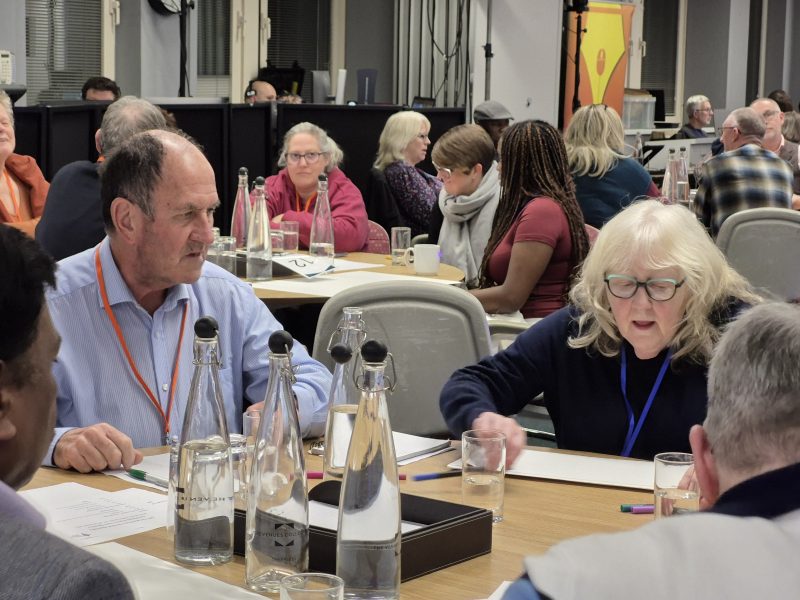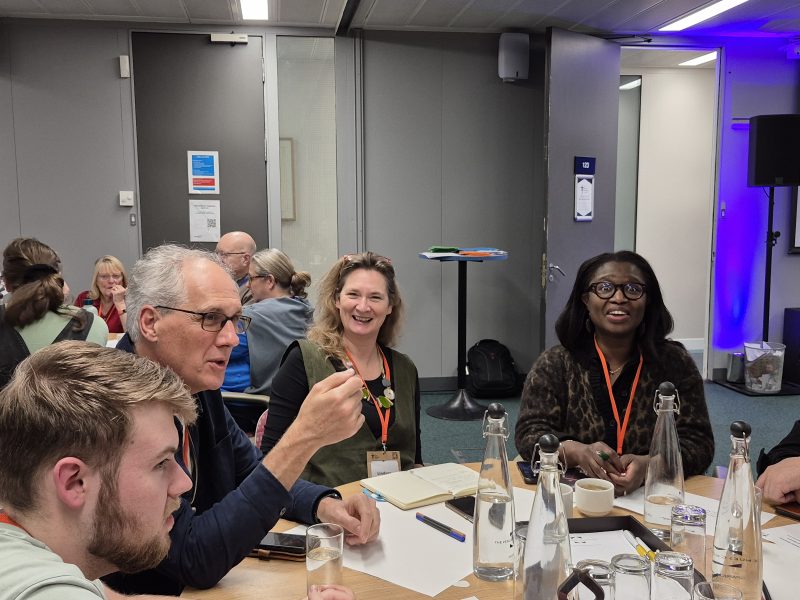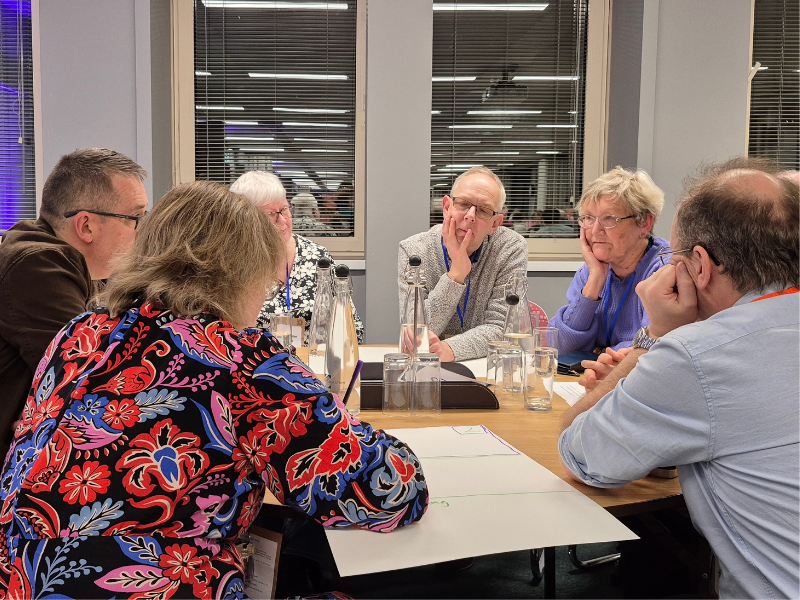Opening Worship
The closing day of the URC’s Extraordinary General Assembly, held at Kent’s Hill Park Conference Centre in Milton Keynes, opened with worship, led by the Revd Jane Wade, Chaplain to the Moderator. Worship began with Assembly singing a moving rendition of The Lord’s my Shepherd [Psalm 23] by Stuart Townend and a reading from Philippians 3:7-21.
The Revd Richard Byass, a minister within the Nottingham North East Circuit of the Methodist Church in Britain, delivered a message of hope and transformation based on the Bible passage and the theme of “growing joy”.
Focusing on Paul’s teaching, the Mr Byass explored the call to “press on,” reminding Assembly that nothing matters more than knowing Christ and continuing the work of God’s Kingdom. He spoke about what he saw as a pattern of “what, how, why, so then…” The What – Pressing on in the work of God’s Kingdom. The How – with steady perseverance: “press on straight.” This means taking faithful risks, seizing opportunities, and moving forward with purpose. The Why – because we are called to live up to what we have already attained. We already carry gifts, foundations, and strengths God has given us. So Then – Growth comes from recognising what is already within and among us so that we can respond to God’s call with hope: a key theme of the Extraordinary General Assembly.
Mr Byass offered words of encouragement to the URC as it moves into the next phase of the Church Life Review (CLR). Transformation is possible — just as creation transforms from the barrenness of winter into spring’s beauty. If simple joys are possible, God can surely bring deeper, more complex joys too. Although the second phase has officially concluded, things may not feel fully settled yet, but it has been strengthened through the resolutions passed.
Discerning sessions
Over the course of Saturday evening and Sunday morning, two sessions of small group discussion and feedback in plenary were facilitated by Gordon Woods.

On Saturday evening, in groups, members of Assembly discussed three questions. In plenary, feedback was shared. The three questions were:
Q. What is our big takeaway from the Church Life Review process?
Q. What is our main hope for the Church Life Fund’s work?
Q. What is the one other thing we wish the CLR had done in Phase Two?
On Sunday morning, a second session focused on the theme, “The path ahead”.
Mr Woods said, “We have not this weekend agreed a blueprint for the URC that will see us through to the end of history.” Paper A10 of the Extraordinary General Assembly had posed a series of questions for more work, grouped under the headings: purpose, people and structures.
Assembly members were asked to prioritise the questions, where 1 = low priority and 5 = high priority. Individual priority ratings were gathered together to create average scores:
Purpose
Q. Who are we as a denomination, what are our priorities? How might be faithfully discern and proclaim God’s prophetic voice? 3.6
Q. How do we articulate our faith in God and share the Good News? 3.9
Q. What would the marks of inclusive, accessible, transformative worship look like in our churches? 3.4
Q. How do we invest in good, sustainable growth, beyond the Church Life Fund? What data/information do we need? 3.4
Q. How can the Church faithfully respond to the challenges of our age, including the climate crisis? 3.8
People
Q. How do we encourage and equip mentor leaders and ministers? 3.8
Q. How do we focus/target ministry, in its many forms, for flourishing? 3.9
Structures
Q. How does M&M need to change? 3.9
Q. What does conciliar look like in the future? Do we need to change The Structure? 3.2
Q. What do we need to do about our property/buildings? 3.3
On this assessment, the top priority questions were judged to be:
- How do we articulate our faith in God and share the Good News?
- How do we focus/target ministry, in its many forms, for flourishing?
- How does M&M need to change?
There was time to think about what makes a flourishing church.
And then a question: How would we draw a picture of the “ingredients” for a flourishing church? Groups took time to draw their images, followed by a final session of feedback.

Snapshot of a discussion
Andy Jackson, the URC’s Head of Communication, reports from one of the 31 groups taking part in the two facilitated discernment sessions.
Gordon Woods, a member of St Columba’s URC, Oxford, led the General Assembly in a series of facilitated discernment sessions. Gordon started by asking how people were feeling. ‘Tired’ (after discussing close to 50 resolutions) was the main response!
The session focussed on the outcomes of the Church Life Review and the opportunities it now presented. Three questions were posed for the groups, with a mixture of people from different Synods in each:
Q. What is the big take away from the first four-years of the Church Life Review?
Members answered that it was an eye opener. The Theos report sparked a lot of positive controversy, and held up a mirror to who and what the church is. There was a lot of cynicism when the whole process started. The resolutions passed delivered outcomes that local churches can do.
One member said a previous review thought that change could be done quickly. The Church Life Review showed that time, money and project management was needed for lasting change to take place. And there was a genuine sense of commitment that the church can do something positively different.
Q. What is the main hope for the Church’s Life Fund’s work?
That it gets used, and that all in the URC hear about it. Lead in time will be needed, and continuous support from Synods. Churches will need time to make applications (although some are already considering this).
The impact of the fund needs to be seen. Not being afraid to share successes and stories about how the fund has been used and what has been achieved.
Q. What is the other thing that we wish the CLR had done?
More theological reflection about who we are as a church – our non-conformity and dissent – and communicating the reason behind the proposed ideas.

In the next session of facilitated table discussions, the Assembly looked at what the priorities of the Church should now be. Answering several questions online and on paper, the group wondered what their understanding of flourishing was.
Questions and comments arose: And what is success and failure? People are one of our resources; how do recruit and retain them? How do we grow disciples? How does a congregation discern what God is doing in the neighbourhood of the church?
The group looked at the importance of local leadership, and the support of and from ministers and local leaders. Does the URC have an identity crisis regarding leadership in a local church?
The group then looked at what the ingredients of flourishing.
The table discussed building a better ecumenical vision, e.g. would a parish/circuit model work better for our churches in specific contexts. How do we enable congregations to have a different vision? Churches should be a safe place, with all involved able to use all of their gifts. Also to be a place known and respected in the community.
Conclusion
The General Secretary, the Revd Dr John Bradbury, concluded with some closing thoughts around the question “So what?”. The Business Committee will reflect on “how we begin to identify the next things that become key priorities”. He gave thanks to those who had made the Extraordinary General Assembly happen.
The Extraordinary General Assembly closed with worship, including Holy Communion.

Reporting: Laurence Wareing, Ann-Marie Nye, Andy Jackson, Steve Tomkins.

